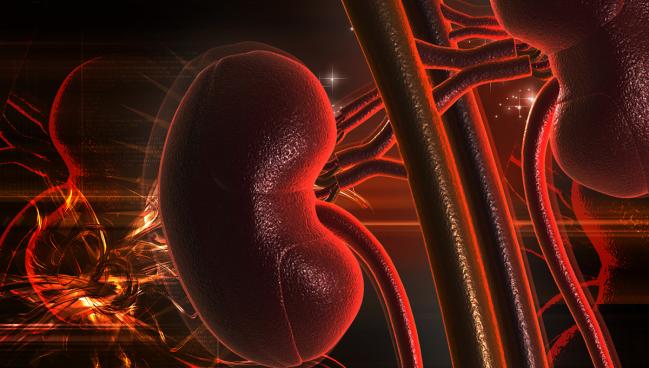Registry Data Hint at MACE Benefit With Renal Denervation
New analyses presented at EuroPCR 2022 support a role for invasive management alongside medications and lifestyle.

PARIS, France—Patients who spend the most time with optimally controlled blood pressure after renal denervation have a lower rate of major cardiovascular events than do those with less-than-ideal blood pressure, a new study suggests.
At 3 years, the MACE rate for those who spent more than 50% of time in therapeutic range (TTR) was 2.9% compared with 10.3% for patients who failed to achieve any TTR and 6.2% for those who spent less than 50% of the time with optimally controlled blood pressure (P < 0.0001).
The new data, from the Global SYMPLICITY Registry of more than 3,000 patients with hypertension who underwent radiofrequency ablation with the Symplicity Spyral catheter (Medtronic), are likely the best the field will see when it comes to clinical outcomes, according to researchers.
Felix Mahfoud, MD (Universitätsklinikum des Saarlandes, Homburg/Saar, Germany), who presented the results today at EuroPCR, said blood pressure-lowering has always been the accepted standard for antihypertensive therapy and it shouldn’t be any different for renal denervation.
“If you want to run an outcomes study, you’d need 20,000 patients enrolled and it would never happen,” said Mahfoud. “These data are encouraging. It has limitations because we’re lacking a control group here, but it shows for the first time that patients with a higher time in therapeutic range have reduced events. That should convince people that lowering blood pressure with renal denervation also translates into improved outcomes.”
David E. Kandzari, MD (Piedmont Heart Institute, Atlanta, GA), coprincipal investigator of the SYMPLICITY clinical trials program, appeared to agree, noting that TTR can be a useful metric to assess the clinical impact of renal denervation. While the registry data do have drawbacks, they are the first hinting that lowering BP with renal denervation lowers the risk of MACE. Moreover, they appear to suggest that it doesn’t matter whether it’s lifestyle, medication, or radiofrequency ablation that shifts blood pressure downwards.
“It’s not so much how you get there, but that you get there,” said Kandzari.
World Hypertension Day
Sofie Brouwers, MD, PhD (Cardiovascular Center Aalst/OLV Hospital Aalst, Belgium), who wasn’t involved in any of the studies, said the initial enthusiasm with renal denervation—those exuberant, halcyon days when investigators reported massive reductions in systolic blood pressure—led some to suspect that medication for hypertension might one day be obsolete.
“I think that was really exaggerated, of course, but I think the data now are really promising on safety and efficacy,” Brouwers told TCTMD. She emphasized that the cornerstone of treatment for hypertension will always remain lifestyle modification, which means increasing physical activity and losing weight if overweight or obese. “Lifestyle should always be the basis of care, with pharmacological therapy optimized, but I do think renal denervation is useful. We use it very often in the hypertension clinic for specific patients who come to us.”
Brouwers said the ideal patient for renal denervation is one with uncontrolled hypertension. That might mean a patient who refuses to take any medication, but also those who are taking multiple medications who can’t get their BP under wraps. “I think there’s a wide variety of data showing where it can be used,” said Brouwers.
Last September, the European Society of Hypertension published a new position statement recommending that renal denervation be considered the third option for the treatment of hypertension alongside lifestyle modification and drug therapy.
At EuroPCR, clinicians devoted a full session to the interventional treatment of hypertension, using the opportunity to highlight two renal denervation programs with different technologies: SYMPLICITY with radiofrequency catheter ablation and RADIANCE with ultrasound-based technology (Paradise; ReCor Medical). The presentations were held to coincide with World Hypertension Day, which is intended to raise awareness about monitoring and treating high blood pressure in the approximately 1 billion people living with hypertension worldwide.
Despite advances in care, a significant proportion of patients with high blood pressure remain undiagnosed or are insufficiently treated with antihypertensive medications, said Mahfoud. The burden of hypertension is increasing rapidly in lower- and middle-income countries but is also increasing in high-income countries. Two large meta-analyses—one published in 2016 and the other in 2021—showed that even modest reductions in systolic blood pressure reduced the risk of major CVD events, including stroke, heart failure, ischemic heart disease, and cardiovascular death.
The problem isn’t that hypertension is not taken seriously, said Mahfoud. Pharmaceutical advances prove that point. “We have available drugs, but patients don’t like them or don’t take then.” Data has shown that nearly one in five patients with resistant hypertension aren’t taking any medication at all and nearly half are only partially adherent to treatment, he said.
Global Symplicity Registry and SPYRAL
The Global SYMPLICITY Registry analysis included 3,077 patients enrolled to date, nearly half of whom had a history of heart disease. Six months after renal denervation, office systolic blood pressure was reduced 13.2 mm Hg. By 3 years, that reduction was 16.7 mm Hg. In terms of 24-hour ambulatory blood pressure, patients undergoing renal denervation had a 9.0-mm Hg reduction by 3 years.
Focusing on TTR, which is a metric that has emerged as a measure of control of chronic disease conditions, the time in range increased from 30.6% at 6 months to 34.9% at 3 years. Measured another way, patients spent an average of 55 days in TTR at 6 months and 377 days in TTR at 3 years.
Investigators observed significantly lower risks of MACE and cardiovascular death among patients with higher TTR. For those with more than 50% in range, cardiovascular mortality was 1.5% compared with 4.0% for those who spent no time in range and 3.5% for those who a TTR below 50%. The stroke rate was 5.4%, 2.4%, and 0.1% for those who spent no time, partial time, and more than 50% in range.
On multivariate analysis, each 10% increase in TTR during the first 6 months of treatment was associated with a 16% lower risk of MACE
In a similar analysis, the SPYRAL HTN-ON MED investigators presented data from that trial showing that renal denervation also led to better BP control. When TTR was defined as office systolic BP ≤ 140 mm Hg, 28.0% of patients randomized to renal denervation were optimally controlled compared with just 13.0% of those treated with the sham procedure. When ambulatory BP ≤ 140 mm Hg was the TTR criteria, 47.8% of those treated with renal denervation were in range compared with 32.0% of those treated with sham.
Kandzari, who led the SPYRAL HTN-ON MED analysis, said TTR is a good metric to use in hypertension as physicians increasingly recognize the lifetime burden of disease. In past studies, TTR has been shown to be an independent measure of BP control, as well as an independent predictor of cardiovascular events.
Pooling Two RADIANCE Studies
Finally, in the third presentation, investigators presented data based on a pooled analysis of RADIANCE-HTN TRIO and SOLO, two sham-controlled trials of ultrasound-based renal denervation. The two studies included different patient populations standardized on a single medical regimen. The RADIANCE-HTN SOLO study included patients with mild-to-moderate hypertension while RADIANCE-HTN TRIO examined the treatment effect of ultrasound-based renal denervation in patients with resistant hypertension.
Despite taking 2.5 medications, on average, at screening, blood pressure was significantly elevated in the RADIANCE patients regardless of how it was measured.
“In other words, these are the types of patients we want to reach on World Hypertension Day,” said lead investigator Ajay Kirtane, MD (NewYork-Presbyterian/Columbia University Irving Medical Center, New York, NY). “Patients who, despite seeing their physicians, have blood pressures that are quite elevated. We know given their age that if they continue with this blood pressure over time, they are going to have adverse sequalae.”
In the combined analysis, the mean between-group reduction in daytime ambulatory systolic blood pressure at 6 months was 4.8 mm Hg. With mean home systolic blood pressure, the between-group difference was 5.4 mm Hg favoring renal denervation (P < 0.001).
While renal denervation doesn’t cure hypertension, the data suggest it can be used safely and effectively as an adjunct to medical therapy across a range of hypertension severity, said Kirtane. At 6 months, patients treated with renal denervation required fewer antihypertensive medications and were less likely to need an additional antihypertensive agent during the 6-month follow-up, he said.
Michel Azizi, MD, PhD (Paris Descartes University, France), who presented the RADIANCE analysis at EuroPCR 2022 emphasized that while the between-group difference is just 5 mm Hg, it is clinically significant. Such a reduction in ambulatory BP, he said, would reduce major CVD events by roughly 10%, as well as reduce the risk of stroke and heart failure by 13% and 14%, respectively.
“This is a large difference,” Azizi told TCTMD. “Also, these are average values. We have large variability from one subject to another, and we have people with a 20-mm Hg reduction in blood pressure, but we are still struggling to find those who are really, truly responsive [to treatment].”
Also, while the between-group difference was 5 mm Hg, renal denervation did result in a 14-mm Hg reduction in mean ambulatory BP. The placebo effect, in other words, was quite large in these trials, said Azizi.
Clinical Work
To TCTMD, Brouwers said that while antihypertensive medications are cheap and widely available and have been proven to lower the risk of MACE, there are some patients who simply refuse to take drugs no matter how strongly she recommends treatment. In this era of patient-centered care, patient preference is important, she said, noting that you can’t force people to take medication.
But there are other things to be tried prior to an invasive procedure, she suggested.
In clinic, one tactic she uses is to emphasize not only the potential risks of stroke and ischemic heart disease, but also the risks of dementia or sexual dysfunction associated with hypertension, which is something that can get patients’ attention. If patients do take medication, her aim is to get patients to goal as quickly possible—within 3 months at least—to show that treatment works, increasing the patient’s confidence in the treatment and hopefully boosting adherence.
Michael O’Riordan is the Managing Editor for TCTMD. He completed his undergraduate degrees at Queen’s University in Kingston, ON, and…
Read Full BioSources
Kandzari DE, Townsend RR, Kario K, et al. Renal denervation increases long-term time in target blood pressure range compared with sham control. Presented at: EuroPCR 2022. May 17, 2022. Paris, France.
Kirtane AJ and Azizi M, on behalf of the RADIANCE-HTN study investigators. Patient-level pooled analysis of ultrasound RDN in RADIANCE-HTN SOLO and TRIO. Presented at: PCR 2022. May 17, 2022. Paris, France.
Mahfoud F. Blood pressure and MACE reductions after renal denervation: 3-year GSR results. Presented at: PCR 2022. May 17, 2022. Paris, France.
Disclosures
- Kandzari results research/grant support from Biotronik, Boston Scientific, Cardiovascular Systems, Orbus Neich, Teleflex, Medtronic, and Ablative Solutions, as well as consulting honoraria from Ablative Solutions, Cardiovascular Solutions, Magenta Medical, Medtronic, and Terumo.
- Kirtane reports institutional funding to Columbia University and/or Cardiovascular Research Foundation from Medtronic, Boston Scientific, Abbott Vascular, Amgen, CSI, Philips, ReCor Medical, Neurotronic, Biotronik, Chiesi, Bolt Medical, Magenta Medical, Canon, and SoniVie. In addition to research grants, institutional funding includes fees paid to Columbia University and/or Cardiovascular Research Foundation for consulting and/or speaking engagements. He reports personal consulting fees from IMDS and travel compensation from Medtronic, Boston Scientific, Abbott Vascular, CSI, Siemens, Philips, ReCor Medical, Chiesi, OpSens, Zoll, and Regeneron.





Comments